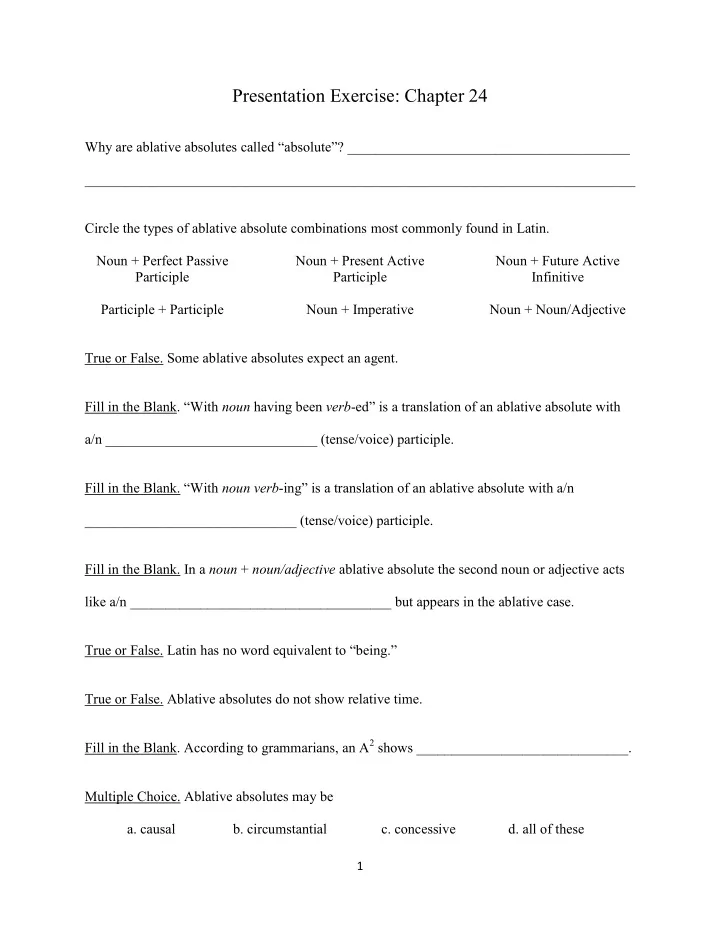

Presentation Exercise: Chapter 24 Why are ablative absolutes called “ absolute ” ? ________________________________________ ______________________________________________________________________________ Circle the types of ablative absolute combinations most commonly found in Latin. Noun + Perfect Passive Noun + Present Active Noun + Future Active Participle Participle Infinitive Participle + Participle Noun + Imperative Noun + Noun/Adjective True or False. Some ablative absolutes expect an agent. Fill in the Blank . “With noun having been verb - ed” is a translation of an ablative absolute with a/n ______________________________ (tense/voice) participle. Fill in the Blank. “With noun verb - ing” is a translation of an ablative absolute with a /n ______________________________ (tense/voice) participle. Fill in the Blank. In a noun + noun/adjective ablative absolute the second noun or adjective acts like a/n _____________________________________ but appears in the ablative case. True or False. Latin has no word equivalent to “being.” True or False. Ablative absolutes do not show relative time. Fill in the Blank. According to grammarians, an A 2 shows ______________________________. Multiple Choice. Ablative absolutes may be a. causal b. circumstantial c. concessive d. all of these 1
True or False. Any noun/s acting as the subject of an ablative absolute can reappear in another function in the same sentence. Multiple Choice. A present participle in an ablative absolute shows ________________ time? a. contemporaneous b. prior c. subsequent d. absolute Convert the verb in the relative-time ablative absolute (in bold ) to absolute time in a clause: Relative Time (A 2 ): With Caesar coming , the enemy fled. Absolute Time (clause): When Caesar ____________________, the enemy fled. Relative Time (A 2 ): With Caesar having been killed , no one rejoiced. Absolute Time (clause): After Caesar _____________________, no one rejoiced. What does the term “ periphrastic ” mean and what is its Latin equivalent? __________________ _____________________________________________________________________________ True or False. The Latin passive periphrastic is a limited form because it can never be active. Fill in the Blank. The future passive participle can also be called a/n ____________________. To it is appended a form of the verb _________________ to create the passive periphrastic. Fill in the Blank. The passive periphrastic is best translated as “ _________________________ ” in the present tense and “ ________________________ ” in past tenses. Fill in the Blank. The future passive participle in a passive periphrastic agrees in case, number and gender with the _____________________ of the construction it belongs to. Pluralize the sentence: Bellum gerendum erat . ________________________________________ 2
Multiple Choice. The agent of a passive periphrastic will always be in what case? Nominative Dative Ablative Genitive Accusative Vocative In the following sentences underline the passive periphrastic construction, circle its agent and translate the sentence into English. Then make the English translation active. Bella nemini gerenda sunt . _______________________________________________________ Active: _________________________________________________________________ Graeci Romanis iuvandi erant . ____________________________________________________ Active: _________________________________________________________________ Urbs vobis delenda erit . __________________________________________________________ Active: _________________________________________________________________ VOCABULARY Complete the information about the vocabulary items discussed in the presentation. For CATEGORY give the declension (adjectives), declension/gender (nouns), conjugation (verbs) or part of speech (others). For OTHER INFORMATION, include elements such as the word’s base. WORD CATEGORY MEANING/S OTHER INFORMATION DUX: ____________ ________________________ ________________________ IMPERIUM: ____________ ________________________ ________________________ SERVUS: ____________ ________________________ ________________________ QUISQUE: ____________ ________________________ ________________________ RE(D)-: ____________ ________________________ ________________________ CUR: ____________ ________________________ ________________________ ACCIPIO: ____________ ________________________ ________________________ 3
WORD CATEGORY MEANING/S OTHER INFORMATION RECIPIO: ____________ ________________________ ________________________ PELLO: ____________ ________________________ ________________________ EXPELLO: ____________ ________________________ ________________________ QUAERO: ____________ ________________________ ________________________ RELINQUO: ____________ ________________________ ________________________ CUPIDITAS: ____________ ________________________ ________________________ NARRO: ____________ ________________________ ________________________ RIDEO: ____________ ________________________ ________________________ 4
Recommend
More recommend